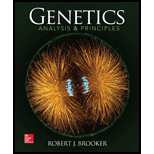
Concept explainers
With regard to pedigree analysis, make a list of observations that distinguish recessive, dominant, and X-linked patterns of inheritance.
To review:
The difference between recessive, X-linked, and dominant patterns of inheritance in accordance with the Pedigree analysis.
Introduction:
Pedigree analysis is the method used to determine the inheritance of genetic disorders. It is an important tool for studying the inherited disorders in the generations. The pedigree chart helps to visualize the relations between the large extended families.
Explanation of Solution
Differentiation between X-linked, dominant, and recessivepatterns of inheritance, according to the pedigree analysis are shown below:
| Recessive inheritance | X-linked inheritance | Dominant inheritance |
| Affected offspring has unaffected parents. | Both, parents and offspring are affected. | Unaffected offspring have affected parents. |
| It is associated with autosomal genes. | Based on the X-chromosome genes. | It associated with the gene on the autosome. |
| Recessive traits affect females and males equally. | Traits skip generations to appear and males are more affected than females. Females are the main carriers of the disease. | Dominant traits affect both male and female offspring in each generation. Dominant X-linked is always passed on from father to daughter. |
Therefore, it can be concluded thatX linked disease affects males, while in dominant inheritance, the disease affects the daughter. In recessive inheritance, both, the males and females have an equal chance of disease inheritance.
Want to see more full solutions like this?
Chapter 24 Solutions
Genetics: Analysis and Principles
- please fill in the empty sports, thank you!arrow_forwardIn one paragraph show how atoms and they're structure are related to the structure of dna and proteins. Talk about what atoms are. what they're made of, why chemical bonding is important to DNA?arrow_forwardWhat are the structure and properties of atoms and chemical bonds (especially how they relate to DNA and proteins).arrow_forward
- The Sentinel Cell: Nature’s Answer to Cancer?arrow_forwardMolecular Biology Question You are working to characterize a novel protein in mice. Analysis shows that high levels of the primary transcript that codes for this protein are found in tissue from the brain, muscle, liver, and pancreas. However, an antibody that recognizes the C-terminal portion of the protein indicates that the protein is present in brain, muscle, and liver, but not in the pancreas. What is the most likely explanation for this result?arrow_forwardMolecular Biology Explain/discuss how “slow stop” and “quick/fast stop” mutants wereused to identify different protein involved in DNA replication in E. coli.arrow_forward
- Molecular Biology Question A gene that codes for a protein was removed from a eukaryotic cell and inserted into a prokaryotic cell. Although the gene was successfully transcribed and translated, it produced a different protein than it produced in the eukaryotic cell. What is the most likely explanation?arrow_forwardMolecular Biology LIST three characteristics of origins of replicationarrow_forwardMolecular Biology Question Please help. Thank you For E coli DNA polymerase III, give the structure and function of the b-clamp sub-complex. Describe how the structure of this sub-complex is important for it’s function.arrow_forward
 Human Heredity: Principles and Issues (MindTap Co...BiologyISBN:9781305251052Author:Michael CummingsPublisher:Cengage Learning
Human Heredity: Principles and Issues (MindTap Co...BiologyISBN:9781305251052Author:Michael CummingsPublisher:Cengage Learning Human Biology (MindTap Course List)BiologyISBN:9781305112100Author:Cecie Starr, Beverly McMillanPublisher:Cengage Learning
Human Biology (MindTap Course List)BiologyISBN:9781305112100Author:Cecie Starr, Beverly McMillanPublisher:Cengage Learning
 Biology (MindTap Course List)BiologyISBN:9781337392938Author:Eldra Solomon, Charles Martin, Diana W. Martin, Linda R. BergPublisher:Cengage Learning
Biology (MindTap Course List)BiologyISBN:9781337392938Author:Eldra Solomon, Charles Martin, Diana W. Martin, Linda R. BergPublisher:Cengage Learning Biology: The Dynamic Science (MindTap Course List)BiologyISBN:9781305389892Author:Peter J. Russell, Paul E. Hertz, Beverly McMillanPublisher:Cengage Learning
Biology: The Dynamic Science (MindTap Course List)BiologyISBN:9781305389892Author:Peter J. Russell, Paul E. Hertz, Beverly McMillanPublisher:Cengage Learning Biology Today and Tomorrow without Physiology (Mi...BiologyISBN:9781305117396Author:Cecie Starr, Christine Evers, Lisa StarrPublisher:Cengage Learning
Biology Today and Tomorrow without Physiology (Mi...BiologyISBN:9781305117396Author:Cecie Starr, Christine Evers, Lisa StarrPublisher:Cengage Learning





